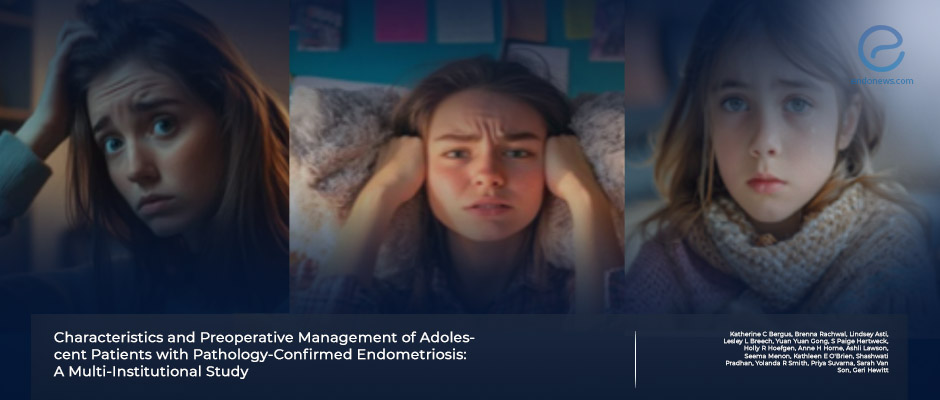Clinical Profiles of Adolescents with Histologically Confirmed Endometriosis
May 30, 2025
Multi-center data from pediatric hospitals reveal gaps and inconsistencies in how endometriosis is diagnosed and managed in adolescents.
Key Points
Highlights:
- There is wide variability in how adolescents with suspected endometriosis are evaluated and managed prior to surgical diagnosis across U.S. institutions.
- Most patients had already received hormonal and analgesic therapy, often without symptom resolution, before undergoing diagnostic laparoscopy.
Importance:
- This study reveals inconsistencies in referral patterns, medical management, and diagnostic pathways in adolescents with biopsy-confirmed endometriosis.
- The findings underscore the need for early recognition, structured evaluation protocols, and consensus-based treatment algorithms in adolescent care.
What’s done here?
- This retrospective cohort study analyzed the clinical characteristics and preoperative management of adolescents with pathology-confirmed endometriosis.
- Data were collected from 305 patients under age 22 across eight pediatric academic hospitals in the U.S. Midwest.
- Variables included age, race, insurance status, presenting symptoms, family history, Mullerian anomalies, comorbidities, and hormonal or analgesic use prior to surgery.
Key results:
- Median age at first pediatric gynecology visit was 15.6 years; median age of menarche was 12.
- Almost half (45.3%) of patients reported a family history of endometriosis; among these, 68.1% involved first-degree relatives.
- Most common symptoms included progressive dysmenorrhea (76.7%), heavy menstrual bleeding (50.8%), and school/activity absenteeism due to pain (55.1%).
- Patients had been seen across multiple specialties—including primary care, GI, adult gynecology, and physical therapy—before diagnosis.
- 92.8% had trialed hormonal suppression; combined oral contraceptives were most common, followed by injectable medroxyprogesterone and oral norethindrone.
- NSAID use was frequent (80.7%), while opioid use remained low (5.9%).
- Three-fourth (73.4%) of patients reported at least one comorbidity, with psychiatric disorders being the most prevalent.
Limitations
- The retrospective design may have introduced selection bias and inconsistencies in data documentation.
- Inclusion was limited to biopsy-confirmed cases, in one hand it is a strength, but it may not reflect the full spectrum of adolescent endometriosis.
- Clinical outcomes following surgery were not assessed.
From the Editor-in-Chief – EndoNews
"This important multi-center study sheds light on a critical but often overlooked population—adolescents with endometriosis. Despite increasing awareness, diagnostic delays and inconsistencies in preoperative management remain common. The authors’ comprehensive chart review across eight pediatric hospitals reveals not only the typical symptoms and treatment histories of affected adolescents, but also the heterogeneity in referral patterns and therapeutic choices.
Perhaps most striking is the high prevalence of comorbid psychiatric conditions, reminding us that the burden of endometriosis in youth extends well beyond pelvic pain. The findings call for a more coordinated, interdisciplinary approach to adolescent endometriosis—one that prioritizes timely diagnosis, patient-centered care, and psychosocial support. This study provides an essential foundation for building consensus-based pathways that can better serve this vulnerable group."
Lay Summary
Adolescent endometriosis is often underrecognized and underdiagnosed, leading to delayed care and prolonged suffering.
In a multi-center study recently published, led by Hewitt al. in the Journal of Pediatric and Adolescent Gynecology, researchers investigated how adolescents with pathology-confirmed endometriosis present clinically and are managed before surgery.
The study reviewed the medical records of 305 adolescents under the age of 22 who underwent diagnostic laparoscopy with biopsy-proven endometriosis across eight pediatric academic hospitals in the United States between 2011 and 2021.
The findings revealed that most patients had already experienced progressive dysmenorrhea, heavy menstrual bleeding, and missed school or activities due to pain. Care pathways were often inconsistent—patients sought help from pediatricians, gastroenterologists, physical therapists, and adult gynecologists before arriving at a definitive diagnosis.
Nearly all patients had tried oral hormonal therapy (mostly combined oral contraceptives) and non-steroidal anti-inflammatory drugs prior to surgery, though opioid use remained uncommon.
Notably, nearly three-quarters of patients reported at least one comorbid medical condition, with psychiatric diagnoses being the most common.
The study highlights a lack of standardization in the early evaluation and management of adolescent endometriosis.
The authors call for more consistent care algorithms to facilitate earlier diagnosis and improve quality of life for young patients facing this chronic condition.
Research Source: https://pubmed.ncbi.nlm.nih.gov/40318750/
endometriosis progressive dysmenorrhea missed school heavy menstrual bleeding

